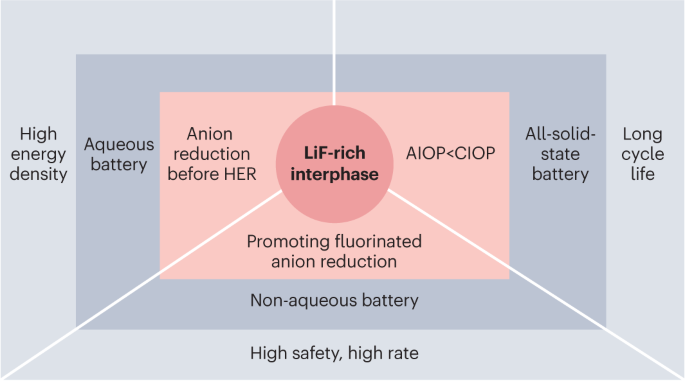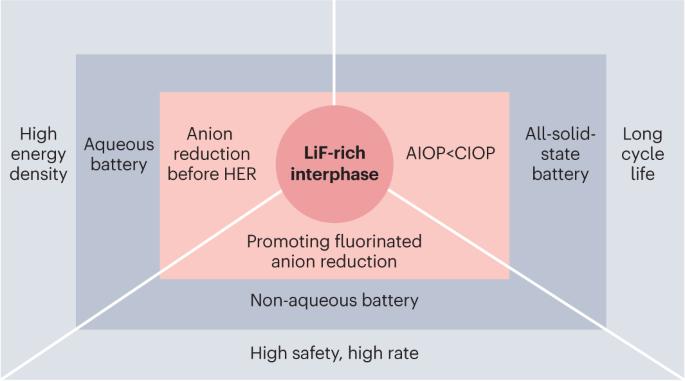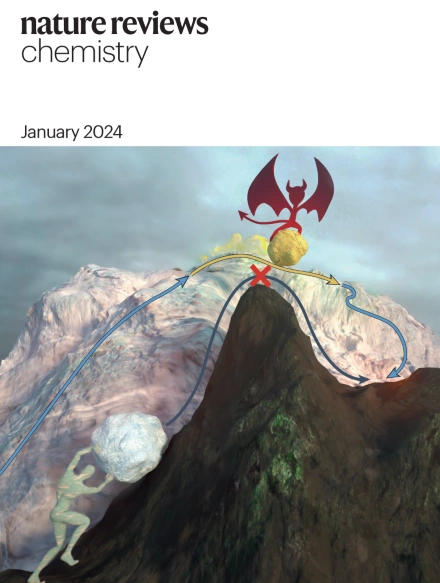为高能锂电池设计电解质和相间物
IF 51.7
1区 化学
Q1 CHEMISTRY, MULTIDISCIPLINARY
引用次数: 0
摘要
下一代电动设备和汽车需要高能量和稳定的锂离子电池。要实现其发展,在高容量阳极和高电压阴极上形成稳定的界面至关重要。然而,某些商业化锂离子电池中的这种界面并不稳定。由于运行过程中的内应力,相间层和电极上会形成裂缝;这些裂缝的存在会形成锂枝晶和新的相间层,导致能量容量衰减。在本综述中,我们将重点介绍在不同电池系统中形成富含锂富集相的电解质设计策略。在水性电解质中,疏水性 LiF 可以扩展水性电解质的电化学稳定性窗口。在有机液体电解质中,高度疏锂的 LiF 可以抑制锂枝晶的形成和生长。旨在形成富含 LiF 相的电解质设计大大推进了高能水性和非水性锂离子电池的发展。本文讨论的电解质和相间设计原理也适用于固态电池,可作为在低堆栈压力下实现长循环寿命的策略,也可用于构建其他金属电池。本文章由计算机程序翻译,如有差异,请以英文原文为准。


Designing electrolytes and interphases for high-energy lithium batteries
High-energy and stable lithium-ion batteries are desired for next-generation electric devices and vehicles. To achieve their development, the formation of stable interfaces on high-capacity anodes and high-voltage cathodes is crucial. However, such interphases in certain commercialized Li-ion batteries are not stable. Due to internal stresses during operation, cracks are formed in the interphase and electrodes; the presence of such cracks allows for the formation of Li dendrites and new interphases, resulting in a decay of the energy capacity. In this Review, we highlight electrolyte design strategies to form LiF-rich interphases in different battery systems. In aqueous electrolytes, the hydrophobic LiF can extend the electrochemical stability window of aqueous electrolytes. In organic liquid electrolytes, the highly lithiophobic LiF can suppress Li dendrite formation and growth. Electrolyte design aimed at forming LiF-rich interphases has substantially advanced high-energy aqueous and non-aqueous Li-ion batteries. The electrolyte and interphase design principles discussed here are also applicable to solid-state batteries, as a strategy to achieve long cycle life under low stack pressure, as well as to construct other metal batteries. This Review provides guidelines for electrolyte and interphase design and discusses LiF-rich interphases with high interfacial energies, high mechanical strength and high ionic:electronic conductivity ratios, which enable the construction of a wide range of highly stable, safe and energy-dense battery systems with fast-charging capabilities.
求助全文
通过发布文献求助,成功后即可免费获取论文全文。
去求助
来源期刊

Nature reviews. Chemistry
Chemical Engineering-General Chemical Engineering
CiteScore
52.80
自引率
0.80%
发文量
88
期刊介绍:
Nature Reviews Chemistry is an online-only journal that publishes Reviews, Perspectives, and Comments on various disciplines within chemistry. The Reviews aim to offer balanced and objective analyses of selected topics, providing clear descriptions of relevant scientific literature. The content is designed to be accessible to recent graduates in any chemistry-related discipline while also offering insights for principal investigators and industry-based research scientists. Additionally, Reviews should provide the authors' perspectives on future directions and opinions regarding the major challenges faced by researchers in the field.
 求助内容:
求助内容: 应助结果提醒方式:
应助结果提醒方式:


